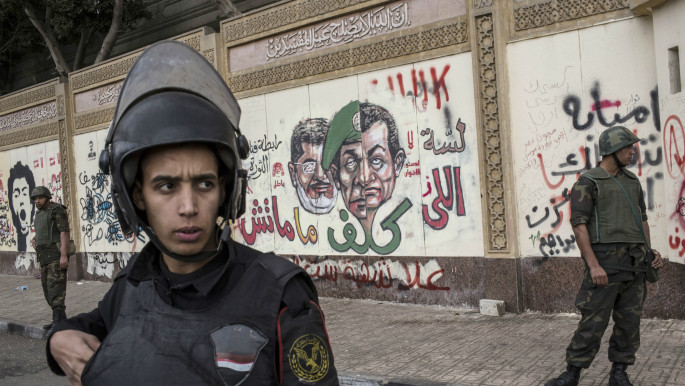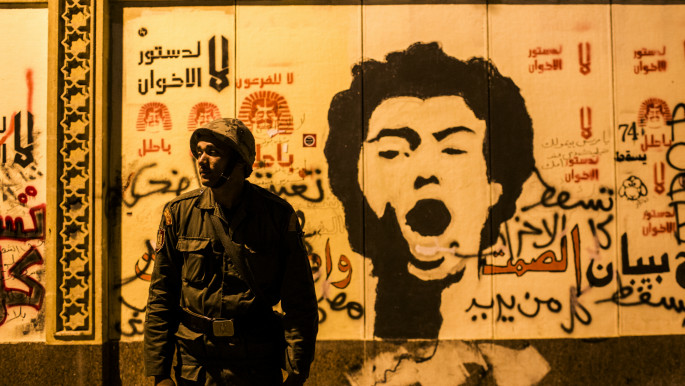Demolishing the revolution: Cairo's iconic graffiti walls destroyed
"They are tearing down the wall in Mohamed Mahmoud and banning anyone from taking pictures. They are trying to erase all traces of the revolution," said one Twitter user in reference to the news.
For many, the Mohammad Mahmoud clashes were emblematic of the military transition period; whereas the revolution had deposed Mubarak, many kept protesting for the next year and a half against the Supreme Council of the Armed Forces (SCAF), which governed post-revolution Egypt and many perceived as continuing Mubarak's repressive system.
 |
|
| Graffitti of Mubarak and Tantawi [Getty] |
"It was a 'battle for the dakhliyya' [the Ministry of Interior building], but that does not mean that any of the young men facing the police necessarily wanted or intended to take over the ministry's building," wrote Lucie Ryzova at the time.
"It was a symbolic battle - or more precisely, a frighteningly real and bloody fight over a symbolic location; the fight itself was the message."
And as the walls of Mohammad Mahmoud were covered in graffiti depicting those who were killed in the battle, the location itself became symbolic of the continuing revolution. The battleground against the Egyptian security forces moved from Tahrir Square to the areas surrounding the ministry of interior building.
Over the years, the meaning of Mohammad Mahmoud and its space became contested.
During the opposition to the President Mohammed Morsi, the clashes' were often cited as a protest that the Muslim Brotherhood failed to take part in.
This was referenced in tweets about the news of the demolition of the walls, as one Tweet read:
"Those who kept saying 'the Brotherhood sold us out in Mohamed Mahmoud should go protest immediately. Are you not real men?"
In 2013, the Egyptian military attempted to put a statue in the street in order to commemorate those who were killed. It was referred to the army's memorial to "its own massacre".
Since the military coup in 2013, the face of Downtown Cairo has changed, and with it so did Mohammad Mahmoud.
 |
|
| "Gika" on the walls of Mohammad Mahmoud [Getty] |
Downtown Cairo and Tahrir has undergone a makeover; the faded buildings in Tahrir have been repainted, the local coffee shops which were previously a haunt for many young activists have been closed down.
Whereas previously there was a lack of security in the Downtown area, and many stalls and pop-up cafes appeared, now the area has returned to its pre-revolution state of being filled with police.
The media office of American University of Cairo - which the wall surrounds - told Ahram Online that demolishing the university's walls in Mohammed Mahmoud Street was part of a renovation plan which included tearing down the university's science building.
The graffiti on the walls of Mohammad Mahmoud was one of the remaining signs that a revolution had taken place in the area.
This last symbol will soon be gone.
One twitter user described it as "a process of gradually breaking up memories of anything meaningful, regardless of its degree of importance."
"They would tear down the whole street and even the entire city if they could", wrote novelist Adhaf Souief.
— Ahdaf Soueif (@asoueif) September 17, 2015
" style="color:#fff;" class="twitter-post-link" target="_blank">Twitter Post
">
|
Those who were killed in Mohammad Mahmoud knew what they were getting into; the majority of the causalities were from the front lines of the fight, that were made up of young people taken on an armed military with broken bits of pavement and Molotov cocktails.
They had grievances, and they went to battle those who were responsible. However, a progressive leadership did not emerge to articulate those grievances and organise the opposition to an oppressive reactionary regime.
After the election of Mohammad Morsi and the subsequent military regime, the revolutionary movement that seemed to be such a unifying and romantic force during the military transition period fractured.
In hindsight many critiqued the movement during that time for having a lack of organization and clear leader, which allowed the reactionary forces to quickly hijack the revolution.
Today, although the faces of the martyrs maybe erased from Downtown, they will be remembered, and there is still hope that their sacrifices will not be in vein.
As another Twitter user said: "Anyway, Graffiti is made to be erased by the regime and then re-made by us again."



